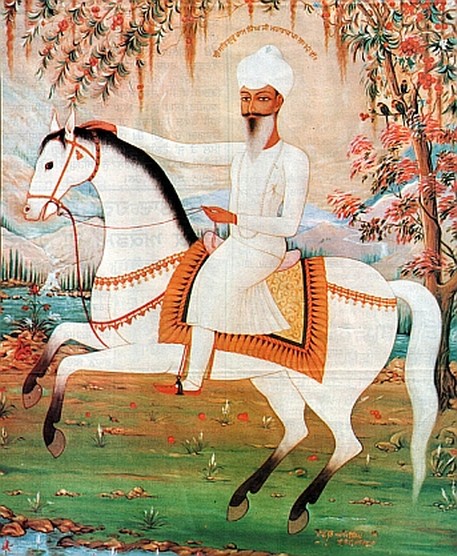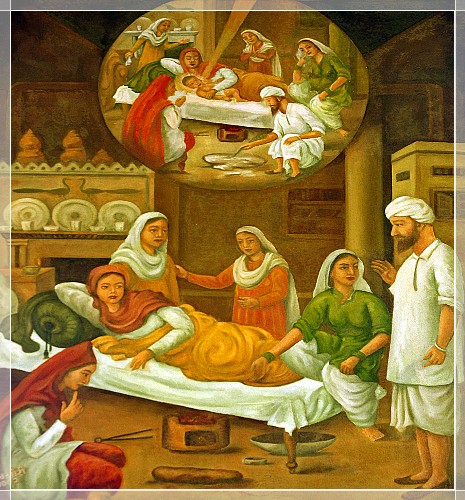namdhari world
Main menu:
- Home Page
- Kuka Faith
- History
- Sikh Gurus
- Namdhari Gurus
- Freedom Fighter - Satguru Ram Singh Ji
- Warrior of Peace
- Non-Cooperation Movement page 1
- Non-Cooperation Movment page 2
- Kuka Postal Service
- No Trial
- Battle for recognition as part of India's struggle for freedom
- Plaque at Ludhiana Railway Station
- Ram Singh Kuka by G.K.Venkateshamurthy
- Social Reforms by Satguru Ram Singh Ji
- Birth of Sant Khalsa
- Kuka Movement - by Film division of Government of India
- KUKA LEHAR - India's first war for independance (1856)
- Satguru Jagjit Singh Ji
- Contradictions
- Historical Quotes
- Vaisakhi - 1699
- Gurmukhi Script
- Sikh Women
- Knowlegde Bank
- Connections
- Places to visit
- Resources
- Music World
- Calendar
- Sports
- ETC...
Basant Panchami
Calendar > Events
THE people of the Punjab are very close to nature. The variegated moods and effects of the climate — the scorching heat of the summer or the chilly and foggy days of the winter — have all been absorbed in their spine. After the rigours of the winter, when the koel (cuckoo) calls in the mango grove, with her notes full of joy, people know that as a messenger of vernal season, she is the harbinger of the pleasant change. They get ready for the spring festivities to be held on the fifth day of the bright half of Magh.
It is the season when the decayed hibernation and through the rebirth, there grow; lotuses among the reeds, the flaming smilings pinks, pushed up in the quagmire by the vital spark, which keeps things alive. In fruits, flowers, foliages among the birds, beasts and humans, the same glorious urge prospers. And that is the cycle of creation. The Basant is a popular folk festival of India and it has undergone numerous changes over the years. In Punjab (both in India and Pakistan), it is the festival of joy, non-sectarian in character, impregnated with the spirit of goodwill towards all.
The origin of the springtime youthful vernal festivities can be traced from the ancient past. The Rig Veda (10.10.6) mentions only three seasons of summer, winter and the spring (Vasant). In its deified personification as the companion of Kamdeva, the god of love, it was the day on which women used to worship the god residing in the bodies of their husbands. The Kamdeva came to be recognised as the wearer of the five arrows — the soft verdant mango leaves, the white lotus, the jasmine, the Ashoka and the blue lotus — signifying tenderness, purity, fragrance, freedom from grief and beauty. Obviously, during the season, these flowers are in full bloom. Maybe, the fifth day of Magh was fixed for the celebrations in view of the five arrows of the god which have been transcended by our thinkers...
Our old festivals adopted various forms with religious overtones. The Basant came out of the palaces to the market place, to the open fields and to the banks of the rivers and the rivulets. Enamoured by yellow sarson fields and the blossoming trees, the whole Punjab gets gay and enjoys the celebrations of the creativity. Clad in the yellow dupatta adorned damsels experience the taste of the changing pattern of nature. The Punjab lives on agriculture. For the brave and the adventurous denizens with their deep association with ecology, the Basant has become the symbols of Punjabi consciousness.
In Punjab, Basant is also the festival of challenges, bravery and brotherhood. Basant Panchami became the festival of the brave and the martyrs. Maharaja Ranjit Singh held a special durbar on this particular day when the soldiers attended the parade in yellow uniforms. Shahid Bhagat Singh adopted the impelling song of Ram Parshad Bismal in the tradition of Rajput soldiers who left their homes to have tryst with death: Mera Rang de Basanti Chola, Maai mera rang de basanti chola (Give yellow hue to my dress, O Mother mine). Even now the brave nihang singhs, clad in the yellow robes emerge from the gurdwaras to display the warlike sports of Gataka and spear wielding.
Along with the traditional melas, the fair is marked by the kite-flying competitions. The kites of the different colours flying as the little stars in the clear sky match the butterflies and bubble-bees among the bushes.
The Basant is the symbol of creation, of love and bliss; of sweet human relationship, of fraternity and commonness. It is the journey from cold to the warmth, from separation to communion. Verily it is the festival of hope pregnant with expectations.


Twenty five kilometres from Ludhiana is located a small village of Sri Bhaini Sahib which embodied a rural life typical in the land of the five rivers. Around its fields, there existed a corporate life led by simple, God-fearing and innocent people. In Such a village was born the great Guru of the Namdhari Sikhs on Baisakhi in the year 1816. This was the day when the fields were green with the crops and the yellow flowers were dancing majestically from the stems of the plants.
Like many other great souls and Saints, Guru Ram Singh had a pious mother who reared him up by Singing to him the verses from the Holy Granth, and by narrating to him the lives and adventures of the Gurus and other Epic heroes.Jassa Singh the father of Guru Ram Singh, held a key position in the village and was greatly respected.
Guru Ram Singh grew up in such a house. He learnt Gurmukhi from his mother and he memorized many parts of the 'Bani.' At the age of 9 Guru Ram Singh began to help his father in many works. While the other boys sang the village folk songs, this promising child always sang verses from the Granth. The others felt amused, then felt interested, and finally joined the religious-minded Guru Ram Singh in reciting the holy Verses.
When the Sikhs were getting ready to start for the battle of Mudki in 1903 (Bikarmi) He was asked to pray for success. He stood for sometime facing the sun in a mood of ecstasy and declared. "Pray or do not pray the Sikhs are not going to win". The Prophecy proved true. When the Sikhs were about to fight at Mudki, Sri Satguru Ram Singh Ji threw his gun into the river (sutluj), and said that he had thrown it then, and others would throw theirs later on.
These were the days of his political education. He saw before his eyes, how the English were advancing towards the Lahore State and encircling it from all sides: sowing seeds of dissension, promoting treason amongst the ranks of the Khalsa: and trying to fulfil their long-cherished ambition.He saw the internal weakness of his community as well as the external danger from the imperialists. Service in the army failed to extinguish the religious flame in his heart; he remained regular in his prayers, forthright in his dealings and elevated in his character.It was while serving in this regiment that he came under the influence of Guru Balak Singh. It is believed by the Namdhari Sikhs that The Guru ship was conferred by the Tenth Gum on Gum Balak Singh of Huzro who passed it on to Guru Ram Singh. This ended his Military career. He return to Bhaini Sahib where he began to devote himself entirely to his people and his own religion.